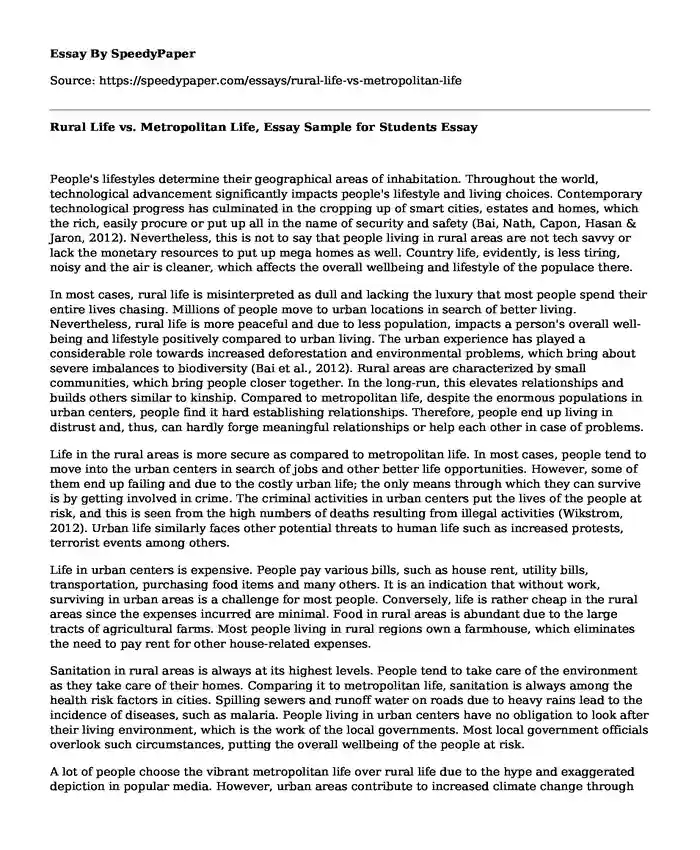People's lifestyles determine their geographical areas of inhabitation. Throughout the world, technological advancement significantly impacts people's lifestyle and living choices. Contemporary technological progress has culminated in the cropping up of smart cities, estates and homes, which the rich, easily procure or put up all in the name of security and safety (Bai, Nath, Capon, Hasan & Jaron, 2012). Nevertheless, this is not to say that people living in rural areas are not tech savvy or lack the monetary resources to put up mega homes as well. Country life, evidently, is less tiring, noisy and the air is cleaner, which affects the overall wellbeing and lifestyle of the populace there.
In most cases, rural life is misinterpreted as dull and lacking the luxury that most people spend their entire lives chasing. Millions of people move to urban locations in search of better living. Nevertheless, rural life is more peaceful and due to less population, impacts a person's overall well-being and lifestyle positively compared to urban living. The urban experience has played a considerable role towards increased deforestation and environmental problems, which bring about severe imbalances to biodiversity (Bai et al., 2012). Rural areas are characterized by small communities, which bring people closer together. In the long-run, this elevates relationships and builds others similar to kinship. Compared to metropolitan life, despite the enormous populations in urban centers, people find it hard establishing relationships. Therefore, people end up living in distrust and, thus, can hardly forge meaningful relationships or help each other in case of problems.
Life in the rural areas is more secure as compared to metropolitan life. In most cases, people tend to move into the urban centers in search of jobs and other better life opportunities. However, some of them end up failing and due to the costly urban life; the only means through which they can survive is by getting involved in crime. The criminal activities in urban centers put the lives of the people at risk, and this is seen from the high numbers of deaths resulting from illegal activities (Wikstrom, 2012). Urban life similarly faces other potential threats to human life such as increased protests, terrorist events among others.
Life in urban centers is expensive. People pay various bills, such as house rent, utility bills, transportation, purchasing food items and many others. It is an indication that without work, surviving in urban areas is a challenge for most people. Conversely, life is rather cheap in the rural areas since the expenses incurred are minimal. Food in rural areas is abundant due to the large tracts of agricultural farms. Most people living in rural regions own a farmhouse, which eliminates the need to pay rent for other house-related expenses.
Sanitation in rural areas is always at its highest levels. People tend to take care of the environment as they take care of their homes. Comparing it to metropolitan life, sanitation is always among the health risk factors in cities. Spilling sewers and runoff water on roads due to heavy rains lead to the incidence of diseases, such as malaria. People living in urban centers have no obligation to look after their living environment, which is the work of the local governments. Most local government officials overlook such circumstances, putting the overall wellbeing of the people at risk.
A lot of people choose the vibrant metropolitan life over rural life due to the hype and exaggerated depiction in popular media. However, urban areas contribute to increased climate change through the increased population, persistent deforestation and massive carbon production. The lifestyle and living habits in urban areas are harmful to both flora and fauna (Bai et al., 2012) The quality of life is higher in rural areas, which importantly plays into a prolonged, fuller and healthier life as opposed to the fast, tiring, unfulfilling and detrimental city life.
Reference
Bai, X., Nath, I., Capon, A., Hasan, N., &Jaron, D. (2012). Health and wellbeing in the changing urban environment: complex challenges, scientific responses, and the way forward. Current Opinion in Environmental Sustainability, 4(4), 465-472
Wikstrom, P.-O. H. (2012). Urban Crime, Criminals, and Victims: The Swedish Experience in an Anglo-American Comparative Perspective. New York, NY: Springer New York.
Cite this page
Rural Life vs. Metropolitan Life, Essay Sample for Students. (2022, Mar 11). Retrieved from https://speedypaper.com/essays/rural-life-vs-metropolitan-life
Request Removal
If you are the original author of this essay and no longer wish to have it published on the SpeedyPaper website, please click below to request its removal:
- Poverty in America Essay Example
- Re-Election Prospects for Paul Ryan. Politics Essay Example.
- Essay Example on the Victim's Rights Movement Oral History
- Water Pollution Essay Example
- Free Essay: Hip-Hop and Its Popularity
- Essay Sample: The Role of Sustainable Interior Design in Nigeria's Economy
- Free Paper Example on Anthropology
Popular categories





